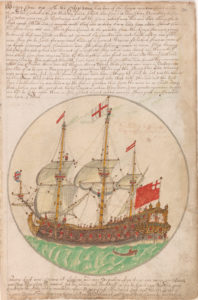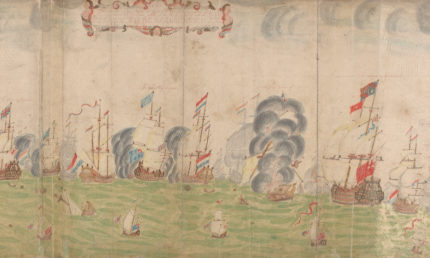 The restoration of a 17th century sailor’s journal in the collection of the National Maritime Museum in Greenwich has revealed a baldly-stated confession of rape that was obscured for centuries in a literal cover-up. The journal was written by one Edward Barlow documenting his four-decade career from 1659 and 1703. He started as an 18-year-old apprentice aboard The Naseby, the flagship of Edward Montagu which brought King Charles II back to England at the Restoration of the monarchy in 1660. Over the forty-plus years of his career, he sailed on navy and merchant ships, participated in several naval battles and was taken prisoner. He detailed all these experiences in his journal. A gifted artist, Barlow illustrated his diary with images of the ships he served on, battles he fought and maps of his journeys.
The restoration of a 17th century sailor’s journal in the collection of the National Maritime Museum in Greenwich has revealed a baldly-stated confession of rape that was obscured for centuries in a literal cover-up. The journal was written by one Edward Barlow documenting his four-decade career from 1659 and 1703. He started as an 18-year-old apprentice aboard The Naseby, the flagship of Edward Montagu which brought King Charles II back to England at the Restoration of the monarchy in 1660. Over the forty-plus years of his career, he sailed on navy and merchant ships, participated in several naval battles and was taken prisoner. He detailed all these experiences in his journal. A gifted artist, Barlow illustrated his diary with images of the ships he served on, battles he fought and maps of his journeys.
Very little is known about Edward Barlow beyond the contents of his journal. Not even the National Maritime Museum has been able to trace the full history of the document. The museum received it from Basil Lubbock, a naval historian, sailor and failed prospector in not one but two gold rushes (Klondike, 1896, California, 1898). He had bought it from Charles Alexander Yorke, Earl of Hardwicke, descendant of Sir Joseph Sydney Yorke, Vice-Admiral of the White. There were no records of how the journal had wound up in the Yorke library. Lubbock thought it likely that some descendant of Edward’s sold the manuscript to Sir Joseph as there were people named Barlow in Hampshire at that time.
Botched repairs over the years had left the journal in dire need of conservation. Its condition issues have been a long-standing concern — senior paper conservator Paul Cook was told when he was hired at the museum in 1985 that the diary was “a problem” — and the painstaking process of restoration has been ongoing for nine years. It was Cook who saw that a page had been very carefully pasted over the original. The cover-up was so expertly performed that nobody had noticed for more than 300 years.
He originally wrote an excruciatingly frank account of his rape of Mary Symons, a young female servant in a house where he was lodging, an encounter he admitted was “much against her will, for indeed she was asleep but being gotten into the bed I could not easily be persuaded out again, and I confess that I did more than what was lawful or civil, but not in that manner that I could ever judge or, in the least, think that she should prove with child, for I take God to witness I did not enter her body, all though I did attempt something in that nature”.
Barlow inserted a line of warning: “I found by her that women’s wombs are of an attractive quality and dangerous for a young man to meddle with.”
He continued that though he wrote “a loving letter”, he wanted to “forget her and blot her out of my remembrance … as I had done with some before”. However, when his ship returned to England from Jamaica, he agreed to meet Symons and found her “weeping most pitifully and saying she was undone”.
Against the advice of friends urging him that he had a good chance of finding a rich wife, Barlow married her in Deal, “a very decent marriage where we had several people of good repute”. The union celebrated with a two-day party that cost him £10.
Their child was stillborn while Barlow was at sea, but they went on to have several more children and, despite initial doubts, he heaped praise on his wife: “Had I searched England over for a mate I could not have met with one more obliging and ready to do any thing that should give me content.”[…]
Cook became the first person in more than 300 years to read Barlow’s original words, hidden under the rewritten version, which included the weeping woman on the shore but omitted the account of the rape. Instead, Barlow wrote: “I had in part promised her at London that I would marry her … having had a little more than ordinary familiarity with her”.
Scholars think that he probably returned from a sea voyage and thought better of his honesty about the brutal origin of what appeared to have developed into a relatively happy marriage.

I wonder why he chose to record this incident and not the prior ones? Because he promised her to marry her?
It definitely shows the lives of women back then. You are taped and then either face the prospect of being a ruined woman or marrying the rapist. I can only hope he ended up being a better man and she had happiness. Hopefully the things she “readily” had to do to make him content were more pleasurable for her.
“It definitely shows the lives of women back then.” What, you mean they were all raped? Really?
You might as well say that the piece shows that all sailors at the time were gifted artists.
The other day, I say a US documentary on that, and I do wonder now if it would it be fair to judge that he ‘supremely courted’ her ‘devilish triangle’,
..i.e. before he shore her up off into marriage?!?
————-
PS: I am afraid, incidents like that do indeed show the life(s) of some of the women.